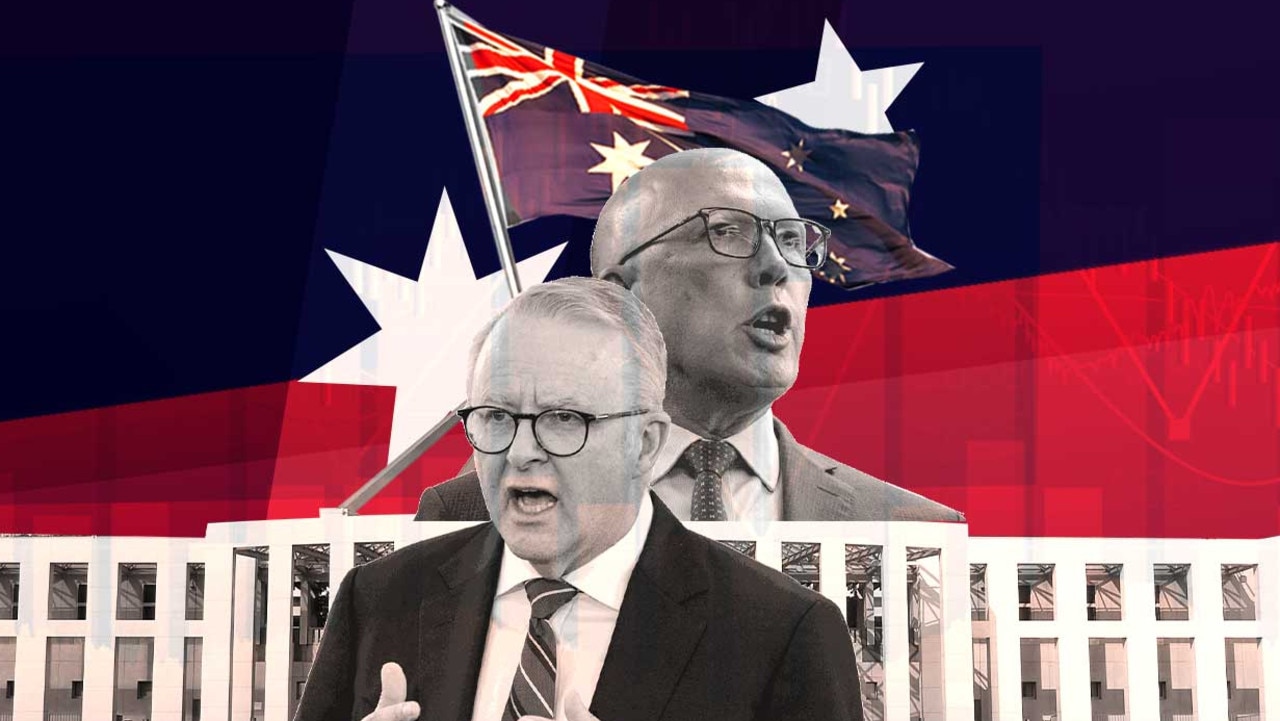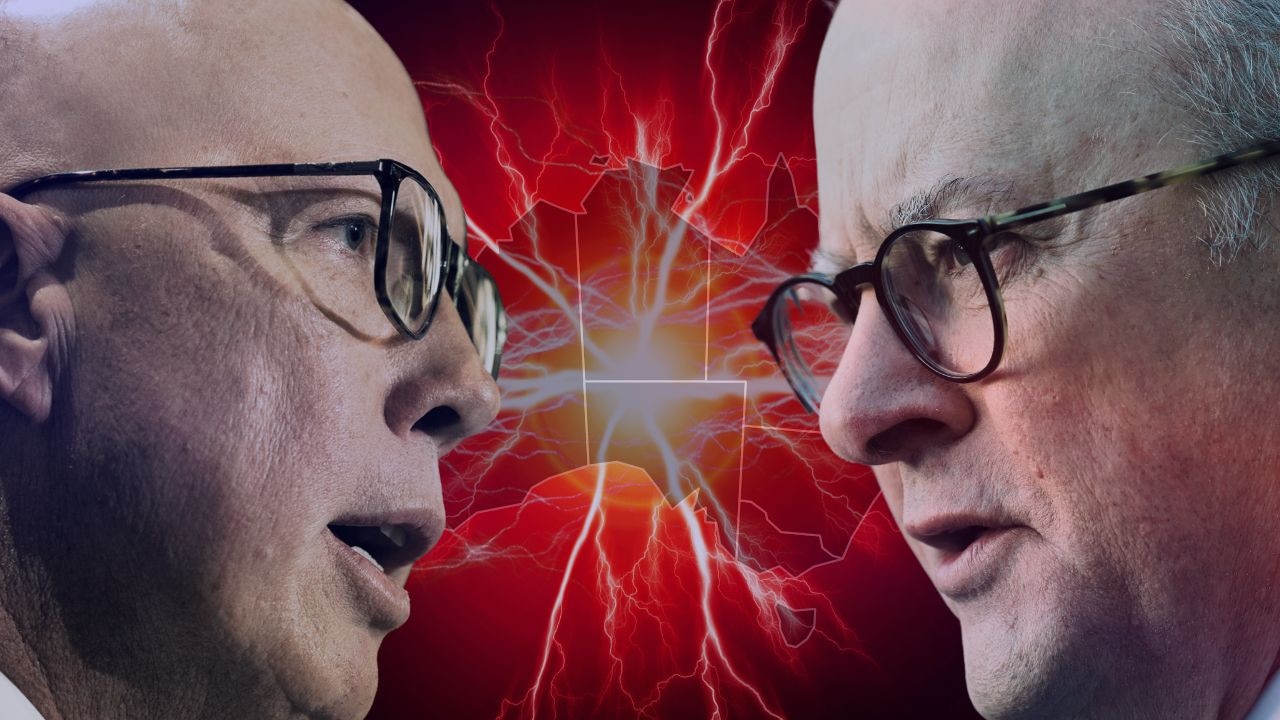Exclusive new poll shows Coalition’s vote in marginal seats collapsing amid Labor’s nuclear scare campaign
Anthony Albanese’s nuclear scare campaign is decimating the Coalition’s primary vote, with Peter Dutton possibly picking up one seat in a battleground state, an exclusive new poll shows.

Latest Polls
Don't miss out on the headlines from Latest Polls. Followed categories will be added to My News.
Labor’s attacks on Peter Dutton’s nuclear plan have cut through with voters and are driving a collapse in the Coalition’s primary vote in marginal seats across Australia, which if left unaddressed is likely to see Anthony Albanese returned in a majority.
With two weeks of the election campaign to go, a clear majority of voters – 56 per cent – agree with the ALP’s claim Mr Dutton’s plan will cost $600 billion and need cuts to pay for it, while only 13 per cent disagree.
In contrast, voters are much more sceptical of the Coalition’s claim that Labor’s reckless spending is driving up inflation and Australia is poorer, less safe and more divided because of Mr Albanese.
They are also more likely to say Labor has better election promises for them.
The results are taken from the fourth wave of the RedBridge-Accent rolling track poll of 20 marginal seats, which found there has been a 9 per cent drop in the Coalition’s primary vote since February.
Worryingly too for the Coalition after months in which the ALP’s support has been much softer than their opponents, the latest survey has found Labor voters are locking in behind the government.
In the first track in February, the Coalition’s primary vote was 43 per cent, which by this week had shrunk to 34 per cent.
But though in the same period Labor’s primary has only grown two points to 35 per cent, the drop in the Coalition primary has been enough to drive a massive shift in the two-party preferred result.
Back in February the Coalition led on a two-party preferred basis – 52 per cent to 48 per cent – a three point improvement since the 2022 election in the 20 seats covered.
This has now been more than reversed with Labor now ahead 54.5 per cent to 45.5 per cent, which if replicated in other marginal seats across Australia on May 3, will see Mr Albanese returned in a majority.
Worryingly for Mr Dutton, the state his support has fallen in the most is Victoria, which is also the state where he needs to win big if he has to have any chance of becoming Prime Minister.
Indeed so big has the collapse been that RedBridge director Kos Samaras warned the Coalition might now only pick up one Victorian seat.
In February the Coalition’s two-party-preferred vote in Victoria was a massive 58 per cent which in two months has shrunk to 51 cent.
The poll also found there has been a big turnaround in the relative popularity of the two leaders.
Back in February the gap between the net favourability ratings of the two leaders was only five points with Mr Albanese on -16 and Mr Dutton on -11.
By April the position of the two leaders had reversed and the gap had widened to 17 points with the PM’s net favourability rating only -5 compared to -22 for the Opposition Leader’s.
The survey also tested how well the two parties’ messages had permeated voters’ minds with Labor’s nuclear attack a clear winner with a ‘net agree’ rating of 43.
Though not as successful, the Coalition’s charge that this is the highest spending government in the past 40 years has also clearly bitten, with 42 per cent agreeing with it compared to 16 per cent who disagree 42 per cent who couldn’t say.
The claim Labor’s reckless spending is driving up inflation has gained some traction with 45 per cent of voters agreeing compared to 29 per cent disagree and 26 who couldn’t say.
On the other hand the charge that Australia is poorer, less safe and more divided because of Mr Albanese was only accepted by 37 per cent voters compared to 36 per cent who rejected it and 27 per cent who didn’t say.
On the question of who has the best election promises for them 36 per cent said Labor ’s compared to 26 for the Coalition and 36 per cent who said neither, they didn’t know or they were the same.
The poll also found the ALP’s vote has firmed up considerably since third track in early April with its “solid” vote jumping from 43 per cent to 59 per cent while the Coalition’s also rose from 62 per cent 67 per cent.
Mr Samaras said the turnaround in the Coalition and Labor position was extraordinary.
“Between our initial key seats track and the latest update, we have witnessed one of the most significant electoral shifts in living memory,” he said.
“The focal point of this dramatic change is Victoria, where the Coalition’s primary vote has plummeted by 11 per cent, erasing their once commanding advantage and potentially limiting them to a one-seat gain.”
Accent’s Shaun Ratcliff said the Coalition’s line that “Australia is poorer, less safe and more divided because of Anthony Albanese” was not really cutting through.
“While the majority of voters who already intend to give the Coalition their first preference agree with this, most others do not, and it also resonates less well with soft voters than those who have already locked in their vote,” he said.
“Something that should ring alarm bells in the Coalition campaign is that soft and leaning voters in particular are turning on the Liberal and National parties, and Peter Dutton, and warming to Albanese and Labor.”
RedBridge’s Tony Barry said “unlike most sequels, Labor’s Mediscare 2.0 campaign is possibly better than the original.”
He said the message linking costs of the Coalition’s nuclear energy plan to cuts to Medicare was “smashing the Liberal brand and Dutton’s personal numbers and that’s atomising the primary vote.”
Fieldwork for Wave 4 of the Election Track was conducted between 9 and 15 April with a sample of 1,000 voters.





